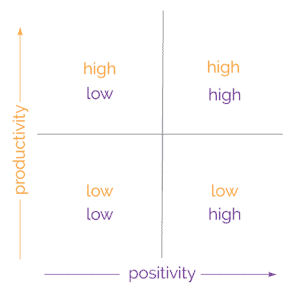by Leah Parkhill-Reilly
If someone asked you what the number one factor was that would make or break a team, what would you say? What will drive a team’s performance through the roof?
I posed that question to a group of senior leaders the other day as I was discussing the enabling and the essential factors that create high performance within teams. When we think about essential conditions, we’re talking about whether it’s a real team with a clear and compelling purpose and composed of the right people. But when we get past the table stakes of purpose and people, there are some real enabling factors that will cause a step-change in performance.
At The Roundtable, we use the Productivity and Positivity model developed by Team Coach International (TCI) as a simple tool to frame those enabling factors. The Positivity factors include aspects of teaming such as optimism, respect, camaraderie, communication, constructive interaction, trust and valuing of diversity. When we think of the Productivity factors, we’re referring to alignment, clear goals & strategies, accountability, proactivity, clear decision-making, access to resources and strength of leadership.
 The model is essentially a 2×2 matrix which allows teams to assess their own current state for their teams. The teams that have the highest levels of productivity and positivity tend to exhibit the highest levels of performance. Those teams that are “high/high” tend to have challenging goals, inspiring vision, they’re in sync, they have open communication, they feed off their success and look to how they can improve, and they have fun.
The model is essentially a 2×2 matrix which allows teams to assess their own current state for their teams. The teams that have the highest levels of productivity and positivity tend to exhibit the highest levels of performance. Those teams that are “high/high” tend to have challenging goals, inspiring vision, they’re in sync, they have open communication, they feed off their success and look to how they can improve, and they have fun.
As we worked through the model during the session, one of the senior leaders commented that she had been on a team that had been “high/high” and dropped to “low/low” (low positivity and low productivity). It doesn’t take much imagination to think about what that work experience feels like. There’s an atmosphere of criticism, blame and cynicism, overwhelm, fire-fighting, turf protection. Long story short, it’s not fun.
So, with that information as context, what factor do you think the senior leaders chose as the one that would most strongly shift the performance of the team?
Trust.
Hands down, trust was the single most important factor, as the start point in creating and sustaining a high-performing team. And I’d have to agree. Without trust, any other efforts are being built on a rather shaky foundation.
So how do we build and maintain trust within teams?
Well, you could try an off-site with ropes courses and trust falls. That might get you some camaraderie but may not get to trust.
What I’ve seen and what I’ve observed in our team sessions is that trust is built when there is “psychological safety.” This is a term that was first coined by Amy Edmondson, at Harvard and has since been popularized through research completed by the People Operations team at Google. Leave it to Google to mine troves of internal team data to determine the factor that truly drove high-performing teams.
What is psychological safety and what does it have to do with trust?
Psychological safety is when there is an environment that allows for an individual to take a risk, speak their mind, engage creatively and basically stick their neck out without fear of retribution.
In Edmondson’s work, she reasoned that it’s linked to our fight-or-flight response. When we are in a “safe” environment we engage with higher-order reasoning processes which allow us to have perspective, be more analytical and long-term (aka strategic) in our thinking. When there is perceived threat such as fear our voice will not be heard or we’ll be dismissed, the higher-order processing power of our brain shuts down and we focus on survival (or getting out of that situation as quickly as possible).
Are you starting to see why psychological safety is connected to trust?
It really makes sense, doesn’t it? Think about how likely you would be to share your challenges or be willing to engage in constructive dialogue if you don’t trust the person sitting on the other side of the table. How comfortable would you be in aligning your work to that of someone else if you didn’t trust that they too were aligned with a broader strategic direction and had good intentions?
How to build it?
Edmondson has a great TEDx Talk where she elaborates on what it takes to build psychological safety but here are the three takeaways:
- Frame the work as a learning problem, not an execution issue.
- Acknowledge your own fallibility.
- Model curiosity and ask questions.
You can also refer to the manager tool that the Google team created as a quick one-page reminder on how to build psychological safety.
At The Roundtable, we’ve seen numerous teams expedite their “storming” using the TCI model and other tools and move toward creating a strong high-performing team. We’ve facilitated numerous sessions and break-through often happens when people can be vulnerable, to call out the “elephant in the room.” At the root of all this work are trust and the development of psychological safety. And if you work within a complex organization with uncertainty and interdependence, you can bet that trust and psychological safety are at the root of whether your team is high-performing or not.
We don’t use trust falls here, but we do have a lot of real conversation that makes major headway in building teams and psychological safety.



